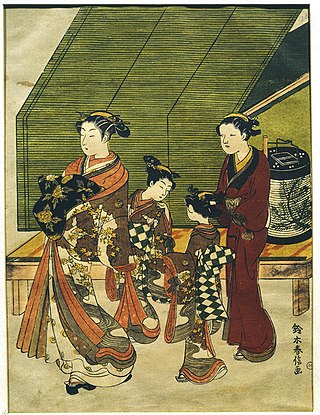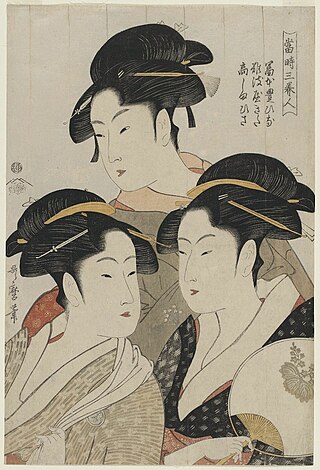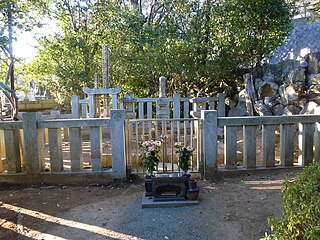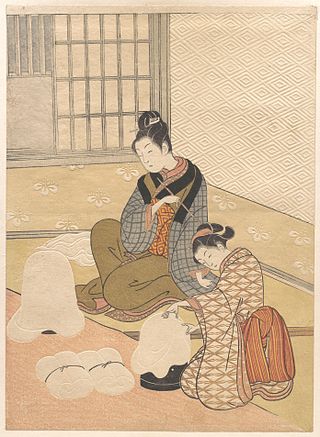
Takeda Shingen was daimyo of Kai Province during the Sengoku period of Japan. Known as the "Tiger of Kai", he was one of the most powerful daimyo of the late Sengoku period, and credited with exceptional military prestige. Shingen was based in a poor area with little arable land and no access to the sea, but he became one of Japan's leading daimyo. His skills are highly esteemed and on par with Mōri Motonari.

Suzuki Harunobu was a Japanese designer of woodblock print art in the ukiyo-e style. He was an innovator, the first to produce full-color prints in 1765, rendering obsolete the former modes of two- and three-color prints. Harunobu used many special techniques, and depicted a wide variety of subjects, from classical poems to contemporary beauties. Like many artists of his day, Harunobu also produced a number of shunga, or erotic images. During his lifetime and shortly afterwards, many artists imitated his style. A few, such as Harushige, even boasted of their ability to forge the work of the great master. Much about Harunobu's life is unknown.
Harunobu is a masculine Japanese given name. Notable people with the name include:

Lunar craters are impact craters on Earth's Moon. The Moon's surface has many craters, all of which were formed by impacts. The International Astronomical Union currently recognizes 9,137 craters, of which 1,675 have been dated.

Takeda Nobutora was a Japanese daimyō who controlled the Province of Kai, and fought in a number of battles of the Sengoku period. He was the father of the famous Takeda Shingen.

Nishiki-e is a type of Japanese multi-coloured woodblock printing; the technique is used primarily in ukiyo-e. It was invented in the 1760s, and perfected and popularized by the printmaker Suzuki Harunobu, who produced many nishiki-e prints between 1765 and his death five years later.
The Battle of Un no Kuchi in 1536 was the first major victory for Takeda Harunobu, aged fifteen at the time. He would later take on the name Takeda Shingen, and grow to become one of Japan's most famous warlords.

Bijin-ga is a generic term for pictures of beautiful women in Japanese art, especially in woodblock printing of the ukiyo-e genre.

Torii Kiyonaga was a Japanese ukiyo-e artist of the Torii school. Originally Sekiguchi Shinsuke, the son of an Edo bookseller, from Motozaimokuchō Itchōme in Edo, he took on Torii Kiyonaga as an art name. Although not biologically related to the Torii family, he became head of the group after the death of his adoptive father and teacher Torii Kiyomitsu.
Takeda Harunobu may refer to two figures in Japanese history:
Arima Harunobu was a Japanese samurai lord who was the daimyo of Shimabara Domain and the head of the Hizen-Arima clan from Hizen Province. In his early years, he was a retainer of Ryūzōji clan.

Shiba Kōkan, born Andō Kichirō (安藤吉次郎) or Katsusaburō (勝三郎), was a Japanese painter and printmaker of the Edo period, famous both for his Western-style yōga paintings, in imitation of Dutch oil painting styles, methods, and themes, which he painted as Kōkan, and his ukiyo-e prints, which he created under the name Harushige, but also producing forgeries of the works of Suzuki Harunobu. He is said to have boasted of his ability to forge the great master so well. He also was engaged in Western learning (Rangaku) in the field of astronomy.

The Hizen-Arima clan is a Japanese samurai family. From 1695 until 1871 they ruled the Maruoka Domain as daimyo. They were appointed Viscount after the Meiji Restoration.

Lady Sanjō was a Japanese noblewoman who lived during the Sengoku period. She was the wife of the daimyo, Takeda Shingen. Her name is unknown and records only refer to her as Lady Sanjō.

Zashiki Hakkei is a series of eight prints from 1766 by the Japanese ukiyo-e artist Suzuki Harunobu. They were the first full-colour nishiki-e prints and are considered representative examples of Harunobu's work. The prints are mitate-e parodies of popular themes of the 11th-century Chinese landscape painting series, Eight Views of Xiaoxiang; Harunobu replaces natural scenery with domestic scenes.
The Okamoto Daihachi incident (岡本大八事件) of 1612 refers to the exposure of the intrigues involving the Japanese Christian daimyō and retainers of the early Tokugawa shogunate in Japan. The conspiracy - motivated by the Christian daimyō Arima Harunobu's desire to retake Arima lands in Hizen that were lost in the Sengoku wars - did much to shake the confidence that the Tokugawa regime placed on its Christian subjects, and was attributed as one of the reasons the Tokugawa eventually took an anti-Christian stance, which culminated in the persecution of Christians throughout the country.













